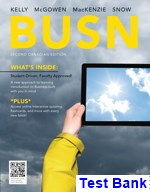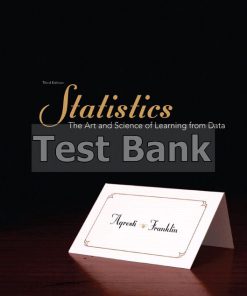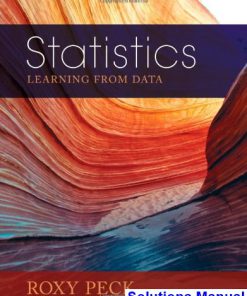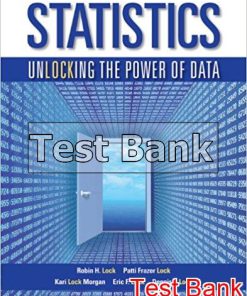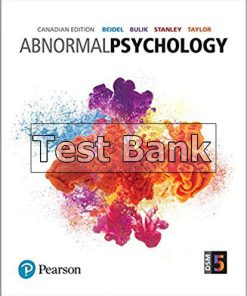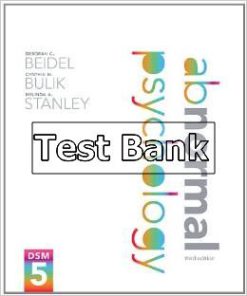Preliminary Edition of Statistics Learning from Data 1st Edition Roxy Peck Test Bank
$26.50$50.00 (-47%)
Preliminary Edition of Statistics Learning from Data 1st Edition Roxy Peck Test Bank.
You may also like
This is completed downloadable of Preliminary Edition of Statistics Learning from Data 1st Edition Roxy Peck Test Bank
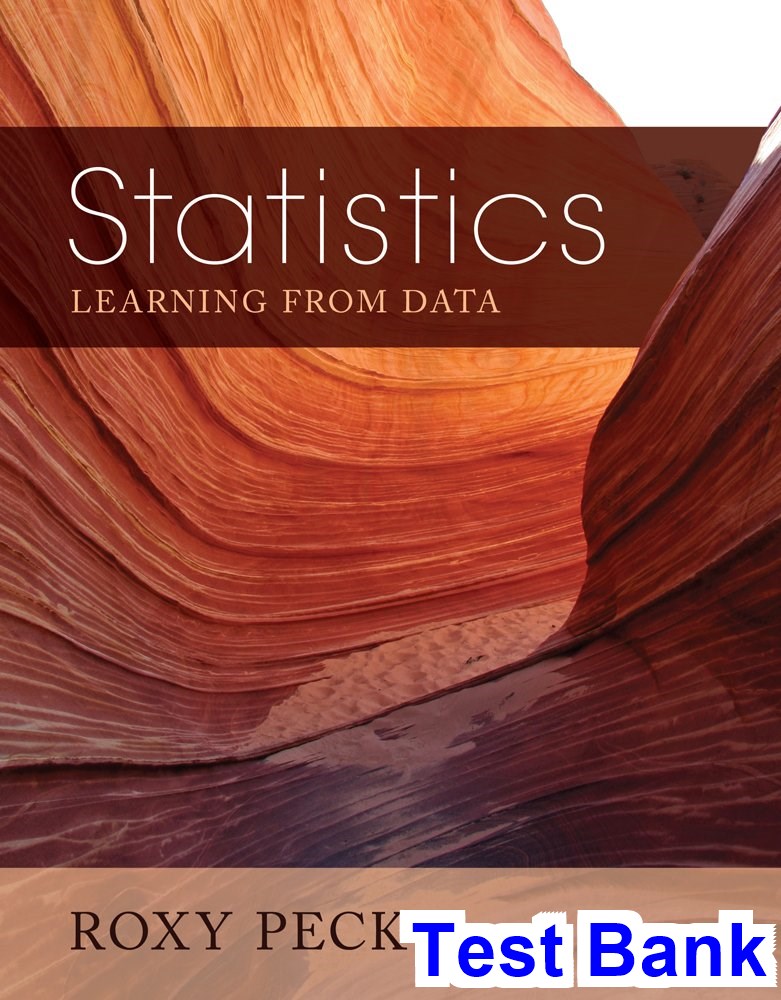
Product Details:
- ISBN-10 : 1285049365
- ISBN-13 : 978-1285049366
- Author: Roxy Peck
STATISTICS: LEARNING FROM DATA, by respected and successful author Roxy Peck, resolves common problems faced by learners of elementary statistics with an innovative approach. Peck tackles the areas learners struggle with most–probability, hypothesis testing, and selecting an appropriate method of analysis–unlike any book on the market. Probability coverage is based on current research that shows how users best learn the subject. Two unique chapters, one on statistical inference and another on learning from experiment data, address two common areas of confusion: choosing a particular inference method and using inference methods with experimental data. Supported by learning objectives, real-data examples and exercises, and technology notes, this brand new book guides readers in gaining conceptual understanding, mechanical proficiency, and the ability to put knowledge into practice.
Table of Content:
- Section I: Collecting Data
- Ch 1: Collecting Data in Reasonable Ways
- Preview
- Chapter Learning Objectives
- Section 1.1: Statistical Studies: Observation and Experimentation
- Section 1.2: Collecting Data: Planning an Observational Study
- Section 1.3: Collecting Data-Planning an Experiment
- Section 1.4: The Importance of Random Selection and Random Assignment: What Types of Conclusions are
- Section 1.5: Avoid These Common Mistakes
- Chapter Activities
- Exploring the Big Ideas
- Are You Ready to Move On? Chapter 1 Review Exercises
- Section II: Describing Data Distributions
- Ch 2: Graphical Methods for Describing Data Distributions
- Preview
- Chapter Learning Objectives
- Preview Example: Love Those New Cars?
- Section 2.1: Selecting an Appropriate Graphical Display
- Section 2.2: Displaying Categorical Data: Bar Charts and Comparative Bar Charts
- Section 2.3: Displaying Numerical Data: Dotplots, Stem-and-Leaf Displays, and Histograms
- Section 2.4: Displaying Bivariate Numerical Data: Scatterplots and Time Series Plots
- Section 2.5: Graphical Displays in the Media
- Section 2.6: Avoid These Common Mistakes
- Chapter Activities
- Exploring the Big Ideas
- Are You Ready to Move On? Chapter 2 Review Exercises
- Technology Notes
- Ch 3: Numerical Methods for Describing Data Distributions
- Preview
- Chapter Learning Objectives
- Preview Example: Brain Blood Volume and Marijuana Use
- Section 3.1: Selecting Appropriate Numerical Summaries
- Section 3.2: Describing Center and Spread for Data Distributions That are Approximately Symmetric
- Section 3.3: Describing Center and Spread for Data Distributions That are Skewed or Have Outliers
- Section 3.4: Summarizing a Data Set: Boxplots
- Section 3.5: Measures of Relative Standing: z-scores and Percentiles
- Section 3.6: Avoid These Common Mistakes
- Chapter Activities
- Exploring the Big Ideas
- Are You Ready to Move On? Chapter 3 Review Exercises
- Technology Notes
- Ch 4: Describing Bivariate Numerical Data
- Preview
- Chapter Learning Objectives
- Preview Example: Help for Crime Scene Investigators
- Section 4.1: Correlation
- Section 4.2: Linear Regression: Fitting a Line to Bivariate Data
- Section 4.3: Assessing the Fit of a Line
- Section 4.4: Describing Linear Relationships and Making Predictions-Putting It All Together
- Section 4.5: Avoid These Common Mistakes
- Chapter Activities
- Exploring the Big Ideas
- Are You Ready to Move On? Chapter 4 Review Exercises
- Technology Notes
- Section III: A Foundation for Inference: Reasoning about Probability
- Ch 5: Probability
- Preview
- Chapter Learning Objectives
- Preview Example: Should You Paint the Nursery Pink?
- Section 5.1: Interpreting Probabilities
- Section 5.2: Computing Probabilities
- Section 5.3: Probabilities of More Complex Events: Unions, Intersections, and Complements
- Section 5.4: Conditional Probability
- Section 5.5: Probability as a Basis for Making Decisions
- Section 5.6: Estimating Probabilities Empirically and Using Simulation (Optional)
- Chapter Activities
- Are You Ready to Move On? Chapter 5 Review Exercises
- Ch 6: Random Variables and Probability Distributions
- Preview
- Chapter Learning Objectives
- Preview Example: iPod Shuffles
- Section 6.1: Random Variables
- Section 6.2: Probability Distributions for Discrete Random Variables
- Section 6.3: Probability Distributions for Continuous Random Variables
- Section 6.4: Mean and Standard Deviation of a Random Variable
- Section 6.5: Normal Distributions
- Section 6.6: Checking for Normality
- Section 6.7: Binomial and Geometric Distributions (Optional)
- Section 6.8: Using the Normal Distribution to Approximate a Discrete Distribution (Optional)
- Chapter Activities
- Are You Ready to Move On? Chapter 6 Review Exercises
- Technology Notes
- Section IV: Learning from Sample Data
- Ch 7: An Overview of Statistical Inference-Learning from Data
- Preview
- Chapter Learning Objectives
- Preview Example: Deception in Online Dating Profiles
- Section 7.1: Statistical Inference-What You Can Learn from Data
- Section 7.2: Selecting an Appropriate Method-Four Key Questions
- Section 7.3: A Five-Step Process for Statistical Inference
- Chapter Activities
- Are You Ready to Move On? Chapter 7 Review Exercises
- Ch 8: Sampling Variability and Sampling Distributions
- Preview
- Chapter Learning Objectives
- Preview Example
- Section 8.1: Statistics and Sampling Variability
- Section 8.2: The Sampling Distribution of a Sample Proportion
- Section 8.3: How Sampling Distributions Support Learning from Data
- Chapter Activities
- Exploring the Big Ideas
- Are You Ready to Move On? Chapter 8 Review Exercises
- Ch 9: Estimating a Population Proportion
- Preview
- Chapter Learning Objectives
- Preview Example: Hurricane Evacuation
- Section 9.1: Selecting an Estimator
- Section 9.2: Estimating a Population Proportion-Margin of Error
- Section 9.3: A Large Sample Confidence Interval for a Population Proportion
- Section 9.4: Choosing a Sample Size to Achieve a Desired Margin of Error
- Section 9.5: Avoid These Common Mistakes
- Chapter Activities
- Exploring the Big Ideas
- Are You Ready to Move On? Chapter 9 Review Exercises
- Technology Notes
- Ch 10: Asking and Answering Questions about a Population Proportion
- Preview
- Chapter Learning Objectives
- Preview Example: Gender Neutral?
- Section 10.1: Hypotheses and Possible Conclusions
- Section 10.2: Potential Errors in Hypothesis Testing
- Section 10.3: The Logic of Hypothesis Testing-An Informal Example
- Section 10.4: A Procedure for Carrying Out a Hypothesis Test
- Section 10.5: Large-Sample Hypothesis Test for a Population Proportion
- Section 10.6: Avoid These Common Mistakes
- Chapter Activities
- Exploring the Big Ideas
- Are You Ready to Move On? Chapter 10 Review Exercises
- Technology Notes
- Ch 11: Asking and Answering Questions about the Difference between Two Population Proportions
- Preview
- Chapter Learning Objectives
- Preview Example: Cell-Phone Fundraising
- Section 11.1: Estimating the Difference between Two Population Proportions
- Section 11.2: Testing Hypotheses about the Difference between Two Population Proportions
- Section 11.3: Avoid These Common Mistakes
- Chapter Activities
- Exploring the Big Ideas
- Are You Ready to Move On? Chapter 11 Review Exercises
- Technology Notes
- Ch 12: Asking and Answering Questions about a Population Mean
- Preview
- Chapter Learning Objectives
- Preview Example: Drive-Through Medicine
- Section 12.1: The Sampling Distribution of the Sample Mean
- Section 12.2: A Confidence Interval for a Population Mean
- Section 12.3: Testing Hypotheses about a Population Mean
- Section 12.4: Avoid These Common Mistakes
- Chapter Activities
- Exploring the Big Ideas
- Are You Ready to Move On? Chapter 12 Review Exercises
- Technology Notes
- Ch 13: Asking and Answering Questions about the Difference between Two Population Means
- Preview
- Chapter Learning Objectives
- Preview Example: Depression and Chocolate
- Section 13.1: Testing Hypotheses about the Difference between Two Population Means Using Independent
- Section 13.2: Testing Hypotheses about the Difference between Two Population Means Using Paired Samp
- Section 13.3: Estimating the Difference between Two Population Means
- Section 13.4: Avoid These Common Mistakes
- Chapter Activities
- Exploring the Big Ideas
- Are You Ready to Move On? Chapter 13 Review Exercises
- Technology Notes
- Section V: Additional Opportunities to Learn from Data
- Ch 14: Learning from Experiment Data
- Preview
- Chapter Learning Objectives
- Preview Example: Injecting Cement to Ease Pain?
- Section 14.1: Variability and Random Assignment
- Section 14.2: Testing Hypotheses about Differences in Treatment Effects
- Section 14.3: Estimating the Difference in Treatment Effects
- Section 14.4: Avoid These Common Mistakes
- Chapter Activities
- Are You Ready to Move On? Chapter 14 Review Exercises
- Ch 15: Learning from Categorical Data
- Preview
- Chapter Learning Objectives
- Preview Example: Is a Baseball Game Really over by the Seventh Inning?
- Section 15.1: Chi-Square Tests for Univariate Categorical Data
- Section 15.2: Tests for Homogeneity and Independence in a Two-Way Table
- Section 15.3: Avoid These Common Mistakes
- Chapter Activities
- Are You Ready to Move On? Chapter 15 Review Exercises
- Technology Notes
- Appendix A: Statistical Tables
- Answers
- Index
People Also Search:
preliminary edition of statistics learning from data roxy peck
preliminary edition of statistics learning from data 1st edition roxy peck
preliminary edition of statistics learning from data
preliminary edition of statistics learning from data 1st edition download scribd
preliminary edition of statistics learning from data 1st edition testbank download pdf
preliminary edition of statistics learning from data 1st edition

































































